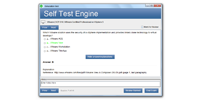JPNTestでEMC D-ZT-DS-23問題集をチョイスする理由
JPNTestは、1週間で完璧に認定試験を準備することができる、忙しい受験者に最適な問題集を提供しております。 D-ZT-DS-23の問題集は、EMCの専門家チームがベンダーの推奨する授業要綱を深く分析して作成されました。弊社のD-ZT-DS-23学習材料を一回のみ使用するだけで、EMC認証試験に合格することができます。
D-ZT-DS-23はEMCの重要な認証であり、あなたの専門スキルを試す認定でもあります。受験者は、試験を通じて自分の能力を証明したいと考えています。 JPNTest Zero Trust Design 2023 は、Dell Securityの158の問題と回答を収集して作成しました。Zero Trust Design 2023の知識ポイントをカバーし、候補者の能力を強化するように設計されています。 JPNTest D-ZT-DS-23受験問題集を使用すると、Zero Trust Design 2023に簡単に合格し、EMC認定を取得して、EMCとしてのキャリアをさらに歩むことができます。
D-ZT-DS-23試験の品質と価値
JPNTestのDell Security D-ZT-DS-23模擬試験問題集は、認定された対象分野の専門家と公開された作成者のみを使用して、最高の技術精度標準に沿って作成されています。
D-ZT-DS-23の迅速なアップデート対応
D-ZT-DS-23試験に変更がございました場合は、現在の試験と一致するよう、瞬時に学習資料を更新することができます。弊社は、お客様に最高、最新のEMC D-ZT-DS-23問題集を提供することに専念しています。なお、ご購入いただいた製品は365日間無料でアップデートされます。
あなたのD-ZT-DS-23試験合格を100%保証
JPNTestテスト問題集を初めて使用したときにDell Security D-ZT-DS-23試験(Zero Trust Design 2023)に合格されなかった場合は、購入料金を全額ご返金いたします。
ダウンロード可能なインタラクティブD-ZT-DS-23テストエンジン
Dell Securityの基礎準備資料問題集には、Dell Security D-ZT-DS-23試験を受けるために必要なすべての材料が含まれています。詳細は、正確で論理的なものを作成するために業界の経験を常に使用しているDell Security によって研究と構成されています。
EMC Zero Trust Design 2023 認定 D-ZT-DS-23 試験問題:
1. What is the primary benefit of applying automation in network security monitoring?
A) It allows for manual analysis of every alert.
B) It reduces the need for a skilled cybersecurity workforce.
C) It increases the complexity of security operations.
D) It ensures timely response to threats by automating repetitive tasks.
2. What are the three main attributes which define an access control decision in ABAC?
A) Roles, Attributes, and Permissions
B) Policies, Rules, and Attributes
C) User, Resource, and Environment
D) User, Role, and Resource
3. A medium-sized company has an internal application running on a Kubernetes cluster. The company wants to expand its IT infrastructure by using resources from cloud to meet scalability.
Which Zero Trust implementation strategy for their hybrid cloud is designed to grant users access to applications based on user identity and context-sensitive trust?
A) Integrated ICAM
B) Secure Access Service Edge
C) Unified Endpoint Management
D) Software defined perimeter
4. Why is continuous monitoring and response a critical pillar in Zero Trust?
A) It enables real-time detection and response to threats, minimizing potential damage.
B) It simplifies IT infrastructure.
C) It ensures uninterrupted user access to resources.
D) It reduces the need for user authentication.
5. Which of the following are key considerations in the design of a data-centric Zero Trust model?
(Select two)
A) Ensuring physical security of all data centers only
B) Classifying data based on sensitivity and value
C) Regularly auditing and updating data access policies
D) Implementing a perimeter-based security model
質問と回答:
| 質問 # 1 正解: D | 質問 # 2 正解: C | 質問 # 3 正解: D | 質問 # 4 正解: A | 質問 # 5 正解: B、C |


 314 お客様のコメント
314 お客様のコメント





